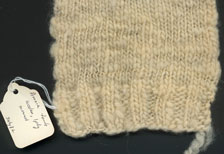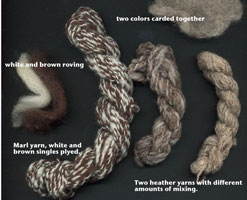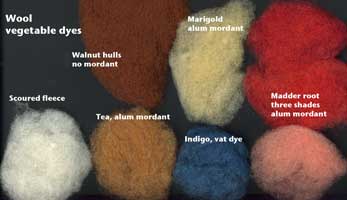
The homespun yarn shown at the left is fairly crude, but can provide interesting textures for simple garments. The main precaution is to measure rather than relying solely on counting stitches and rows in your patterns.
Making a fabric by knitting involves drawing loops of thread or yarn through a series of loops held on needles.
In knitting as in crochet, the fabric you create can be worked in rows from a written pattern or chart or done in the round. For knitting back and forth, often a set of two needles with a point on one end and a cap on the other are used. For circular knitting of smaller items, such as socks and mittens, four needles are used. Two are used for the knitting while the other two hold the work. Circular needles consisting of a pair of rigid points joined by a flexible section can be used for large items of circular knitting.
There are many ways to make your knit items interesting.


Wool comes in a variety of shades of white, tan, brown, to black that can be spun separately or carded together to get natural heather shades. One of the advantages of using natural wool is that as it requires less treatment than dyed wool, it tends to be stronger and can wear better. The natural lanolin (grease fleece) can be used to lubricate the wool during carding and spinning, especially if the fleece is recently shorn. A final wash sets the twist and removes soil. Often the lanolin is left in.
Advantages of using natural colors are that sometimes people who are "allergic" to wool are actually reacting to dyes, moth proofing chemicals, or other treatments, so can comfortably wear the natural wool. A third advantage is that the natural colors don't bleed, so you don't have to wash colors separately.
White wool can be colored with natural vegetable dyes or synthetic dyes to produce a wide palette of fashion colors. This usually requires that the wool fibers be scoured or washed in strong soap and/or washing soda to remove the lanolin. For an indigo vat or vegetable dyes that contain natural mordants (like the tannic acid in walnut hulls) no further treatment is need. Other natural dyes, like the marigold flowers and madder root in the photo, require that the scoured wool be treated with alum to make the color bind.
The yarn itself can provide texture variations. It can be spun from fine or coarse fibers. Spinning techniques, such as bouclé or plying thick and thin strands can add texture interest.
Varying stitches from stockinette gives textural interest plus can add thickness to a garment. Traditional fisherman jerseys and Aran sweaters can employ quite elaborate patterns and provide a challenge to the experienced knitter.
Be sure to check your gauge carefully on stitch patterns, especially if you are making your own designs. Patterns need more stitches than stockinette. Make a generous swatch, then block it and check the gauge.